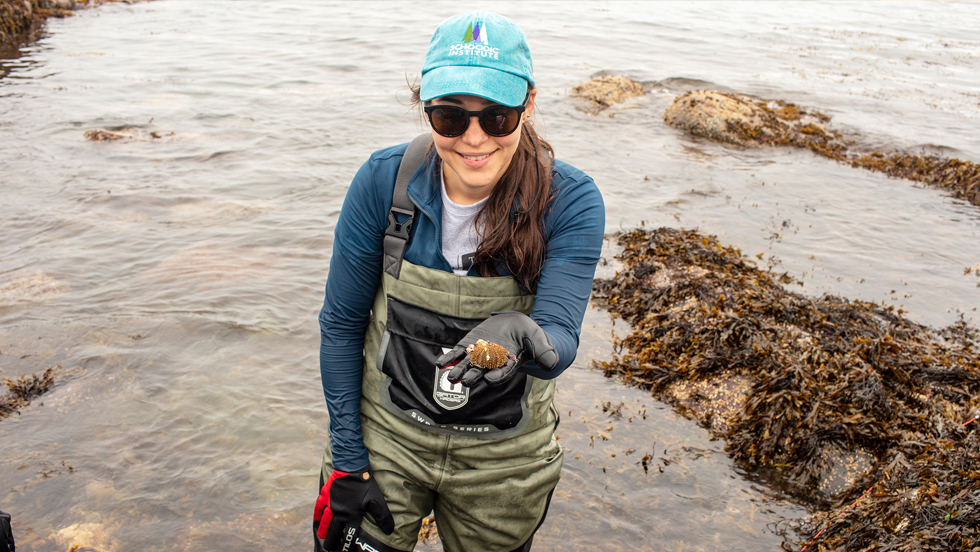
Melina Giakoumis '11, PhD, a conservation biologist, science communicator and mother who advocates for women in STEM, is building an app for citizen scientists to help track—and protect—declining Asterias sea stars.
During her years studying for her doctorate, Melina Giakoumis ’11, who earned her PhD in biology and is now a conservation biologist and the associate director of the Institute for Comparative Genomics at the American Museum of Natural History, often walked along the shore looking for the sea stars she was researching. Although she was initially interested in understanding the genomics of these species, she was concerned with how few sea stars she was finding. She decided to broaden her research to gather data on whether these important Asterias populations were declining unnoticed.
She pitched the idea to the National Park Service in 2020, and received funding from the Schoodic Institute as part of the Second Century Stewardship research fellowship program.
At Adelphi, Dr. Giakoumis double majored in environmental studies and anthropology and was a member of the Honors College. She also participated in several study abroad programs, including studying marine biology at Australia’s Great Barrier Reef. It was here that she discovered her passion for marine conservation. Now, she is developing an app that anyone can download and use to contribute to her study, part of a growing movement by scientists to embrace what is known as “citizen science.”
In Fall 2023, Dr. Giakoumis returned to her alma mater virtually to present “Conservation of Sea Stars in the North Atlantic Ocean” for Adelphi’s Artivism series.
Here, she shares what interested her about sea stars, why she is creating the app, and advice for women in STEM.
Why sea stars?
Sea stars are keystone species, which means they have a disproportionately large effect on their communities. Their presence or absence on the coast in these intertidal [areas between high and low tide] communities can shape the types of species that can live there.
They’re also under-studied. In a marine context, people think about more charismatic animals, like endangered whales. Yet sea stars are one of the few invertebrate species that people connect with—they get really excited when they go to the beach and find a sea star. So you can get the wider community engaged with your research.
How will your app help with your research?
One of my hypotheses about why sea stars are declining involves Sea StarWasting Syndrome, which is a disease that has high mortality and likely affects sea stars regularly. We have no baseline data for how often sea star wasting outbreaks are happening or how severe they are. If we can crowdsource that information through people who are already out on the beaches in the North Atlantic, we can have a much better idea of where this is happening, what time of year it’s happening, and how severe it is.
How does the app work?
When you see an animal, you take a picture and upload it with a location. Then students can review the images and confirm whether the sea stars are sick [and give us] baseline data for when these outbreaks are happening. I’m sure scientists will be some of the primary users, but I hope we’ll get users who are not scientists as well. More boots on the ground is always better. In a study that I am hoping to publish soon, I have some pretty striking results and have documented that the density of sea stars is declining really rapidly.
What does your work at the Museum of Natural History involve?
Along with my own research, I run the Institute for Comparative Genomics Data, working under the director of the Institute for Comparative Genomics. As associate director, I manage the staff and make strategic long-term decisions about the future of the program. I also work and manage several different genomics labs … [including one] lab that we call the Ancient Biomolecules Lab, which is equipped to extract DNA from very old specimens from museum collections. We’re one of only a couple of institutions equipped with a lab of that caliber.
What advice do you have for women entering STEM fields?
Find a community of support. I’ve been a part of the New York Women in Natural Science group at the Museum of Natural History for over a decade, and it’s been invaluable to me to have a community that wants to support women in science. We reach out to each other about specific problems, find ways to address them and push for institutional change, because there’s power in numbers. And if there isn’t a community you can join, then build one.
How have you adjusted from being a woman scientist to being one who is also a mom?
It’s fun and it’s amazing, but it’s a whole new world with a whole new set of challenges. But I have a lot to look forward to—hopefully, one day my daughter will look to me for some of the same advice I’ve shared today!